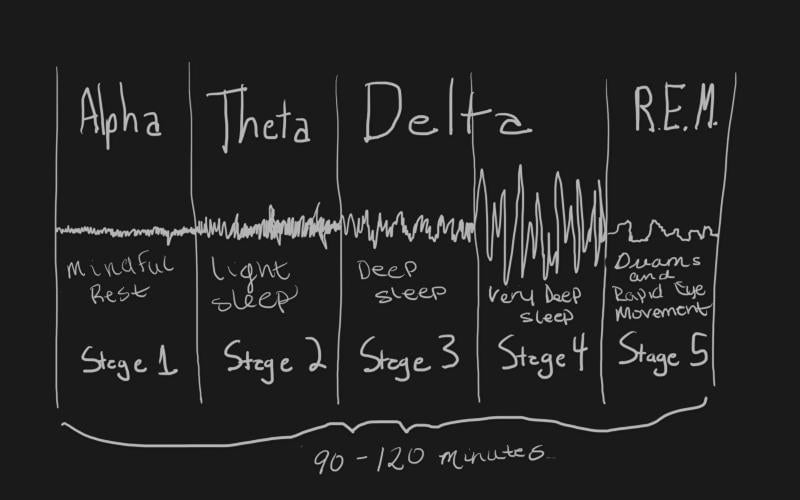How to put your mind—as well as your body—to sleep
My sleep schedule:


My sleep schedule:
- 8:30: Get ready for bed.
- 9:00: Be in bed.
- 9:30: Hopefully be sleeping.
- 9:55: Definitely be sleeping.
- 10:00: Oh god, you’re not asleep? Why aren’t you asleep? You know what happens when you can’t sleep. Well, you just keep thinking about sleep. I mean wait, don’t think about sleep! Just don’t even think about the word.
- 10:05: Now it’s ruined, it’s all ruined.
- 12:30: Is someone vacuuming? I am pretty sure someone is vacuuming. I will find them. I will find them, and I will hurt them.
- 1:00: *silent rage until sleep comes*
Much of my life is dictated by my fear of not falling asleep at the right time. I calculate how much sleep I need down to the exact minute. I lay in bed each night waiting for the unyielding thought-vomit to occur. I used to think that the endless stream of thoughts that plagued my nightly routine were unique to me, but I couldn’t have been more wrong.
If you have trouble turning your mind off at night, you aren’t alone. It is estimated that 30 to 40 million Americans have a sleep disorder and an additional 20 million have occasional difficulty sleeping. It’s so bad that the Centers for Disease Control considers it a public health epidemic. To unearth the reasons why we can’t turn off our mind at night, we should first understand the body’s mechanisms which govern sleep.
Until as recently as the 1950s scientists believed that falling asleep was a completely passive process. Scientists now think that the body’s wakefulness and sleep mode is dictated by a two-process model:
Process S: Promotes our desire to sleep and inhibits our arousal centers at night.
Process C: Maintains our wakefulness during the day.
This two-process model is also influenced by the circadian rhythm.
The circadian rhythm is the body’s clock that regulates our activities and behaviors. It’s controlled by the suprachiasmatic nucleus (SCN)—a part of the brain known as the circadian rhythm pacemaker. Morning light lets the SCN know “Hey, it’s time to get up and start this process over again.” As the sun sets, the SCN signals our body to clam down and prepare for sleep.
Disruptions to the circadian rhythm can prevent us from falling asleep at night and feeling overly tired during the day. These disruptions can also adversely effect our health.
Shift workers have an increased risk of heart problems, digestive disturbances, and emotional and mental problems, all of which may be related to their sleeping problems. The number and severity of workplace accidents also tend to increase during the night shift.
Okay, so we understand the process that drives us to sleep, but what happens to our bodies once we are in bed?
There are two kinds of sleep, Rapid Eye Movement (REM) sleep and Non-REM (NREM) sleep. Both of which are necessary for the body to go through its restorative process. There are also five stages of sleep. The entire process takes about 90-120 minutes. In an ideal situation, it would look something like this:

When we can’t turn off the mind it is because we are having trouble transitioning from the alpha waves of stage one to the theta-band waves of stage two.
Those with severe sleep disorders often enter REM sleep immediately upon falling asleep. As we begin the transition into sleep our brains are letting go of a lot, but this is by no means a passive process. Our brains are reordering and assessing the day’s events, working to promote new memory formations, and cleaning up debris.
Turning off our mind—as anyone who has tried to do will tell you—is easier said than done. There’s no magical switch you can flip to make yourself fall asleep, but there are some tricks you can do to help quiet your mind.
1. Cool yourself down
Part of the body’s process for falling asleep each night involves a lowering of the body temperature. If you are in a room that is too hot it can disturb your internal sleep processes. To get slightly more technical, the metabolism of your brains frontal cortex wants to be cool when falling asleep. Insomniacs have a higher metabolism in their frontal cortex which is said to contribute to their inability to sleep. The body loses its ability to regulate its temperature at night, so finding the right balance is important.
2. Buy red lights
You know that sort of bluish glow given off by our TVs, computers, and phones? That seemingly serene blue light is literally robbing you of sleep. The short-wavelength of blue light stops the production of melatonin—a hormone necessary for sleep. Exposure to blue light can even throw off our circadian rhythm. If purchasing all red lights is a bit too drastic for you, aim to reduce the amount of light you use at least two hours before bed.
3. Breathe out of your left nostril
In yoga this is called nadi shodhana, or alternate nostril breathing. Cover your right nostril and practice breathing in and out of your left nostril ten-times. The practice of breathing through your left nostril is said to help relax your sympathetic nervous system. Just simply focusing on the task of breathing can help you drown out other distractions.
4. Go outside in the morning
Being in the sun—especially upon first waking—tells our circadian rhythm to reset itself. The best time for this to happen is between 6 and 8:30 a.m. You should aim for at least 30-minutes of sun exposure a day to receive the maximum benefits. Sunlight inhibits the production of melatonin, which is responsible for making you tired. Being tired during the day will likely rob you of that feeling later at night when you need it the most.
5. Visualize yourself asleep
You are a leaf on the wind, watch how you soar off to sleep land. Visualizations draw focus away from thoughts which have emotional content. Experts say it is important to associate positivity with sleeping. This can help remove some of the anxiety we have built up around falling asleep each night. Researchers at Colorado College recently found that the simple act of believing that you received more sleep than you did is enough to give your brain some of the positive effects of sleep.
There are a lot of really useful sleeping tips out there, but they are all variations on the same theme. Preparing the mind and body for sleep is all about reducing the emotional content in our thoughts and eliminating as much external stimuli as possible. You should absolutely explore a variety of sleep routines and practices. Doing so can help you understand the barriers that prevent you from achieving a quiet mind.
Sleep is a process. It doesn’t just happen the moment you get into bed. The body is preparing itself for sleep all day. It actually helped me to think of sleep something ongoing as opposed to something that was just supposed to happen. It took some of the pressure off of me. My body was actually made to do this. Trusting and listening to my body’s natural process really helped me find a better way to fall asleep.
Crew publishes regular articles on creativity, productivity, and the future of work. Enter your email here to get their weekly newsletter. You can also follow Crew on Twitter and Facebook.